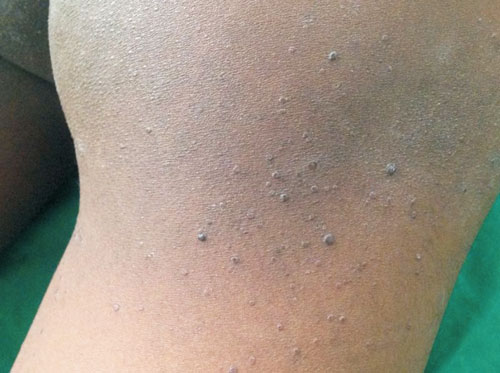|
|
|
Indian Pediatr 2015;52: 175 |
 |
Angiokeratoma Corporis Diffusum
|
*A Jayavardhana, Pradeep Balasubramanian and AM
Vijayalakshmi
Department of
Paediatrics, PSGIMS&R, Peelamedu, Coimbatore
.Tamil Nadu, India.
Email:
[email protected]
|
A 13-year-old boy presented with history
of fever and burning pain of the hands and feet for 10 days.
He had four similar febrile episodes with burning pain of
the hands and feet over the last one year. He also had
hypohidrosis and heat intolerance. On examination, the child
had multiple discrete reddish-brown papular non-blanchable
lesions with keratotic surface extending from umbilicus to
the knee in the ‘bathing trunk distribution’ (Fig.
1). Based on the clinical findings a diagnosis of
Fabry’s disease (FD) was considered. Biopsy of one of the
papular lesions showed multiple dilated capillaries with
plenty of red blood cells within the lumen and the overlying
epidermis showed mild hyperkeratosis suggestive of
angiokeratoma corporis diffusum (ACD) (Fig. 2).
The enzyme
a-galactosidase
(a-GAL)
in the leukocytes revealed very low levels of the enzyme
(0.38 nmol/hr/mL; fluorometry method), thus confirming the
diagnosis of Fabry’s disease.
 |
|
Fig. 1 Multiple discrete
reddish brown papular lesions of angiokeratoma.
|
 |
|
Fig. 2 Biopsy of the
papular lesion showing multiple dilated capillaries
and hyperkeratosis of overlying epidermis.
|
For many years, ACD was considered
synonymous to Fabry disease, a systemic X-linked disease
caused by deficiency of the lysosomal enzyme ‘a-GAL’
resulting in the accumulation of ‘globotriaosylceramide’.
ACD can also occur in association with other diseases
related to deficiencies of enzymes that are involved in the
metabolism of glycoproteins which include fucosidosis,
sialidosis, a-mannosidosis,
GM1 gangliosidosis, and Kanzaki disease . The disorders
other than FD is typified by characteristic facies, mental
retardation and organomegaly which were absent in the
present case and the occurrence of acral paraesthesia and
hypohidrosis were further suggestive of FD. Differential
diagnosis of the cutaneous lesions must exclude the
angiokeratoma of Fordyce spots, angiokeratoma of Mibelli,
and angiokeratoma circumscriptum, none of which has the
typical histologic or ultrastructural lysosomal storage
pathology of the Fabry lesion.
Treatment of FD may include enzyme
replacement therapy (ERT) using recombinant human
a-GAL,
analgesics (carbamazepine, or gabapentin), ACE inhibitors
and dialysis or renal transplantation for end stage renal
disease.
|
|
|
 |
|

